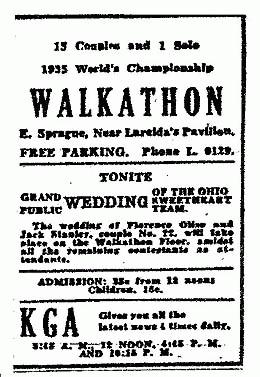On October 12, 1935, a dance marathon/walkathon closes in Spokane after 1,638 hours (that is, 68 days, or more than two months). Professional marathoners Joe and Mary Rock, a brother and sister team, are declared the winners in promoter Charles M. Hayden’s Spokane Dance Marathon/Walkathon. Dance marathons were Depression-era human endurance contests in which couples danced almost non-stop for hundreds of hours (as long as a month or two), competing for prize money.
Drama, Misery, Hope, Flim-flam
Dance marathons (often called walkathons in an attempt to make them sound more wholesome) were an American phenomenon of the 1920s and 1930s. Mounted by professional promoters and often using local sponsorship to grease civic wheels, the contests at their peak "employed an estimated 20,000 people as promoters, masters of ceremonies, floor judges, trainers, nurses and contestants" (Martin, p.xvi). Encompassing human drama, human misery, vaudeville-style entertainment, and flim-flam, combined with prodigious advertising and a field of professional contestants seeded with local hopefuls, dance marathons drew large crowds at bargain prices.
Spokane audiences paid 15 cents to watch contestants shuffle and "lug" (sleeping while hanging onto a partner who is dancing) during the day. Admission during the evening hours, when entertainment was scheduled, was 25 cents. Contestants danced around the clock, with 15-minute breaks each hour. They were fed (they ate standing up and moving their feet) 12 times per day.
The Ohio Sweetheart Team
The contest was held in a 6,000-seat capacity circus-style canvas tent on East Sprague near Lareida’s tourist camp. Evening entertainment included dance marathon staples like Country Store Night on August 2, 1935, which featured a grocery give-away, and a public wedding in which the "Ohio Sweetheart Team … Florence Ollie and Jack Stanley" (Spokesman Review, August 8, 1935) were married with audience as wedding guests and fellow contestants as attendants.
Advertisements on August 3, 1935, promised a " ‘Big Midnight Frolic’ with the 'Ton of Fun' and other Comedians -- Comic Skits, Singing, Dancing and Good Lively Entertainment All Night! Also, Inland Empire Amateur Contest" (Spokesman-Review). Radio station KGA broadcast updates from the contest four times daily.
Exhausted But Sprinting
The Spokane contest employed sprint races to weed out competitors. These fast races, during which the already exhausted couples raced full-tilt around the arena, stipulated a "one fall and out" rule (The Billboard, August 31, 1935, p.30).
The winning couple, Joe and Mary Rock, were a brother and sister team who worked the West Coast marathons. Their famed ability to outlast the competition earned them the moniker "Iron Horses" (Calabria, p.27). The Rocks defeated second place team Jack Alexander and Esther Witherall by outlasting them in a one hour and 17 minute running derby race. The contest had been going on for 1,638 hours.
The Rocks and their runners up became local celebrities. After the marathon concluded they "played three days at the local Orpheum Theatre" (The Billboard, October 19, 1935), presumably as a floor show preceding the feature film, George Burns and Gracie Allen in Here Comes The Bride.

